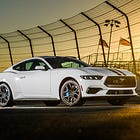60 years on, Mustang still an American icon
'Everyone instinctively knew, even with zero car knowledge, that Mustang was special.'
CHARLOTTE — On April 17, 1964, at the New York World’s Fair, Ford unveiled its all-new Mustang.
Ford Vice President Lee Iacocca, an auto executive almost as iconic as the car he introduced, had teased the Mustang a few months earlier in a press release that read: “The new line of cars will be called the Mustang ... no further details on the new car line will be revealed until the time of its public introduction.”
In an industry as famous for its flops as its hits, it’s impressive to see any nameplate last 60 years, much less one as enduringly iconic as the Ford Mustang.
Starting at $2,368 in ’64 — about the cost of the upgraded tire package on the ’24 car or $24,000 in today’s dollars — the Mustang was almost infinitely customizable. Depending on the owner’s desires, it could be made more sporty or more luxurious. It could be a family car with spacious backseats or a teenager’s dream makeout vehicle. It had the longest list of options ever offered on a car from Detroit, which was the Mustang’s other significant contribution to automotive history.
Ford execs hoped it could sell 100,000 of the car named for a fighter plane in its first year of production, which would be a decent hit for the boys from Dearborn. They sold 22,000 on the first day.
Within three years, GM and Chrysler came chasing with the Challenger and Camaro, and Steve McQueen made it clear that the competition was always a step or two behind.
The Mustang remains a classic, enduring and jaw-dropping even today. There’s a reason “Gone in 60 Seconds” cast a ’67 Fastback as Eleanor in both the original and the remake. Everyone instinctively knew, even with zero car knowledge, that Mustang was special.
“You have a vehicle that’s already a hit, and it gets used in movies and gets even cooler,” Bob Casey, an automotive historian and former curator of the Henry Ford Museum, told me in an article I wrote for WIRED about the 50th anniversary of the Mustang. “You too can be like Steve McQueen! They picked it because it was a car that Steve McQueen would drive.”
It hasn’t been all glitz and glamour and Hollywood starlets. The ’74 Mustang failed to live up to its name. Based on the Pinto, it was slow and, worse, not very pretty. But then the Fox body Mustang showed up in 1979, really hitting its stride with the GT in 1982.
That car cemented the Mustang’s place as a cultural icon, especially for 40ish millennials like me. Sure, Vanilla Ice (who rapped about dropping the top on his “five-point-oh”) ain’t no Steve McQueen, but the green-backlit instrument cluster remains so well-known that Ford included it as a not-so-secret Easter Egg in the latest generation Mustang (which comes standard with a pair of giant digital screens, which Bullitt definitely didn’t have).
The seventh-generation Mustang was released last year, and I adore it, not least because Ford — unlike GM and Dodge — had the courage to buck the EV proponents and release a (mostly) new one. There’s a new performance version called Dark Horse with more than a whiff of McQueen about it, and Ford is teasing something even cooler for a big 60th-anniversary party today in Charlotte.
A few years back, Ford built its 10 millionth Mustang — a white unit that lives at the Ford Archives in Dearborn — and it’s difficult to imagine a car that’s generated more memories.
Sure, Toyota has sold 50 million Corollas (I was taken aback when I looked up that particular number), but that practical, reliable workhorse doesn’t make the heart skip a beat like the pony car.
Mustang enthusiasts might decry the 2024’s “base” 2.3-liter turbocharged EcoBoost four-cylinder engine as “underpowered,” but they look pretty foolish doing it.
The 1982 GT (with that venerable 5.0L V8) made 157 horsepower, but the entry-level 2024 Mustang gallops out 315 horsepower. Shockingly, one only has to return to the 2010 Mustang GT’s 4.6L V8 to equal that. And the Dark Horse makes a whopping 500 horsepower, putting even Eleanor to shame (at least under the hood).
Sixty years later, the Mustang is as American as ever, even if tastes have changed a bit. It’s no longer the family car it once was, though it starts around $30,000, so it remains (somewhat) affordable. More than that, though, nostalgia is strong these days as Americans search for something familiar and comforting to grab hold of.
And what’s more familiar than the most iconic car America has ever made?









